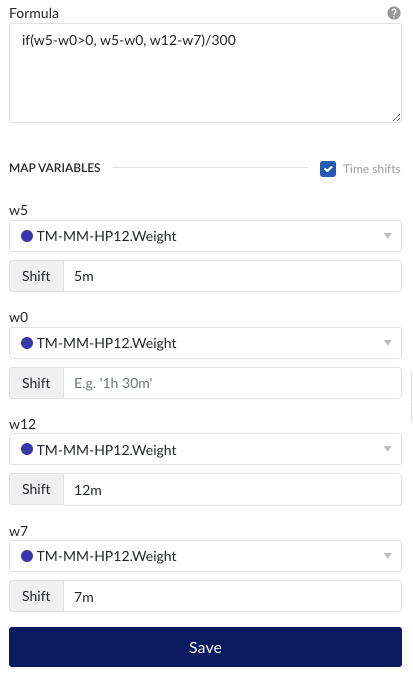Rate tag
A rate tag is a tag that gives an indication of flow or speed. This section deals with creating a new rate tag when all we have is some measure of a total amount, commonly a weight or a level tag. This is especially applicable to the processing of solids, where measuring a flow directly is challenging. For simplicity, we'll work with the concept of deriving a mass flow from a total weight in this section.
In essence, the mass flow is nothing more that then change (delta) of the weight, multiplied by a constant value. However, typically the weight follows a sawtooth pattern where a continuous decrease is interrupted by sudden increases (refill of the dosing unit), which we will need to account for in our formula.
 |
We can do this by setting the output of our mass flow formula to zero whenever our weight is increasing (i.e., the unit is being filled). We do make a mistake with such a formula if we keep on dosing while refilling, as the outgoing flow would still be positive. There is no way of knowing what the actual outgoing flow was during refilling periods, as we are both filling and emptying at the same time and we only have a single measurement. We could reduce the size of our mistake, however, by not setting the flow to 0 during these periods, but to a contant value that we think approaches the average flow. A more complex solution is to look back to the period before the filling, and use the flow there as an estimate for the flow during the filling. This works if our flow is relatively steady, and we know the refill only takes a maximal amount of time (so we know how far we should look back).
 |
A rate tag at its most complex. The outgoing flow is given by the difference between weight 5m ago and the current weight, divided by 300 to get the flow per second (as there are 300 seconds in 5 minutes). When this value is negative, however, it means that we are refilling. In that case, we use the rate 7 minutes ago (same calculation, but with a +7m shift) as an estimate for the rate during the refilling. For this to work, the refilling time always needs to be below 7 (the shift) - 5 (the delta period) = 2 minutes. If it is longer, we need to go back further for a flow estimate.